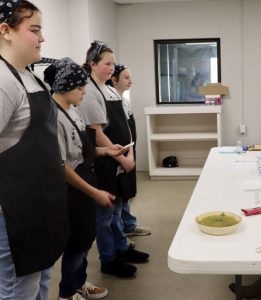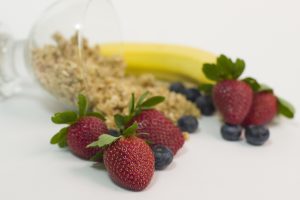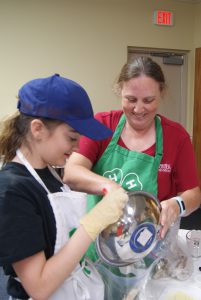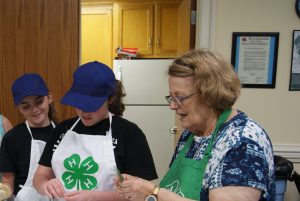by Marie Arick | Feb 5, 2024
For the second year, Escambia County takes the top spots… across all three age divisions! The Intermediate and Senior teams will be competing in the State Food Challenge in Tampa February 17th!



The Florida 4-H Food Challenge Competition provides an opportunity for youth to gain food safety and preparation knowledge and skills using a competition to allow for the display of what they learned. Additionally, these youth must champion teamwork, use a mystery item to create a dish for a specific category (main dish, side dish, appetizer, or healthy dessert), purchase complementing food products for their recipe from the competition pantry on a limited budget, and create the dish for judging. To cap it off, teams must provide an oral presentation to the judges summing up all their efforts and highlighting their culinary creation. This presentation ideally includes how they implemented food safety, decided upon their recipe, recipe preparation, how it fits into MyPlate, nutritional content and possible healthier substitutions. All dishes are required to be a minimum of two servings and senior teams also provide a cost per serving. Judges may quiz youth regarding their presentation and dish after the team presentation.
This year, the Northwest District Food Challenge competition was the largest in the state hosting 10 teams. Once again, Escambia County took the top spot in all three age divisions with the intermediate and senior teams advancing to the state competition at the Florida State Fair in Tampa in February.
The life skills attained with the Food Challenge program will serve these youth for the rest of their lives. Harvard Health notes when you cook and prepare meals at home, they are overall more nutrient dense, use healthier preparation practices and are most cost effective. If you are interested in this program, contact your local 4-H Office.
Scroll below to see all the teams during their presentations. Senior teams were presented with the mystery item of avocado and category of side dish. Intermediate teams were assigned chickpeas and appetizer. Junior teams were assigned fire roasted tomatoes and main dish.











by Prudence Caskey | Jan 11, 2024
As we enjoyed a beautiful Christmas day in the panhandle, we need to start to brace for some colder weather as we welcome the new year. Here are a few ideas on how to protect your animals in the colder weather. During this upcoming cold snap, your “critters” will rely on you to survive it. As you think about how to best protect your outside pets and livestock, remember the three W’s. (more…)
by Claire Davis | Oct 18, 2023
 Finally, Fall is in the air! It seems like it takes forever for summer to leave Florida. What better way to kick off the Fall season than by bobbing for or picking a deep red, bright green, or yellow apple? Currently, there are over 2,500 varieties of apples grown in the United States, and 7,500 varieties grown throughout the world. Did you know that apples are also grown in all 50 states? That is a lot of apples to celebrate throughout the month of October and on National Apple Day, October 21!
Finally, Fall is in the air! It seems like it takes forever for summer to leave Florida. What better way to kick off the Fall season than by bobbing for or picking a deep red, bright green, or yellow apple? Currently, there are over 2,500 varieties of apples grown in the United States, and 7,500 varieties grown throughout the world. Did you know that apples are also grown in all 50 states? That is a lot of apples to celebrate throughout the month of October and on National Apple Day, October 21!
Have you ever heard the saying, “An apple a day keeps the doctor away”? This was something that I was told throughout my childhood. I did not believe that an apple a day would keep me healthy and away from the doctor’s office. Now I understand that the saying is a tribute to the apples nutritional value and its health benefits. Per the USDA, an apple is an excellent source, for your daily nutrition, of fiber and vitamin C!
Apples are a great fruit to add to our diet! With the hundreds of varieties available, there is an apple to suit almost anyone’s taste. Apples can be sweet, tart, crisp, crunchy, soft, or mushy, however you like them. To determine what apples you like best, try hosting an apple tasting. Purchase different types of apples, cut them up into slices or silly shapes, and serve them fresh. If you are feeling adventurous, try smothering your apple slice in peanut butter, hazelnut spread, or in a yogurt dip. The flavor combinations are endless.
Maybe you or your children do not care for the taste of apples. That’s ok! There are several activities you can still participate in to celebrate National Apple Month and Day. I have compiled a short list of activities to give a try.
-

Roadside market produce. Photo taken 12-12-22.
Apple bowling. All you will need for this activity is 6 bottles, an apple, a starting line, and a way to keep score.
- Apple towers. See how many apples you can balance on top of one another. The tower with the most apples wins!
- Apple Puzzle. This will take a parent with “expert” knife cutting skills to cut the apple into several pieces. Take them apart and try to put it back together.
- Apple Painting. Cut your apple in half or different shapes, dip into your paint, and you’ll have a masterpiece on your hands in no time.
- Apple Rotting. For this experiment, you will need an apple, four drinking glasses, water, oil, and vinegar. Quarter your apple and place into the cups. Fill three of the cups with water, oil, or vinegar separately. The remaining glass will have just air. Make a hypothesis on which apple slice will decompose the quickest and which will last the longest.
https://fdc.nal.usda.gov/fdc-app.html#/food-details/171688/nutrients
https://medlineplus.gov/ency/article/002404.html
https://health.cornell.edu/sites/health/files/pdf-library/fiber-digestion-health.pdf
40 Easy Apple Activities for Kids to Experiment, Create & Learn
by Claire Davis | Sep 28, 2023
Now that school is back in full swing for our kids, it can be hard to make sure they are eating nutritious foods at each meal. I know that I fall short when I make meal and snack choices, imagine how difficult it is for a kid. Follow along below to learn more about why it is important to make healthy choices, as well as how to teach youth to make healthy breakfasts and afterschool snack choices!

Strawberries, blueberries, cereal grains, and a banana. Fragaria, fruits, foods, red, sweets, healthy eating. UF/IFAS Photo: Tyler Jones.
Why should I make healthy choices?
That is a great question! As a busy mom of two, I am always trying to balance work, school, family, and our social calendar. Healthy eating is essential for everyone. Your eating habits can contribute to physical movement, sleep, health, energy levels, and education. I can tell a large, postivie difference in my overall attitude, energy levels, and sleep when I am making better choices. Have you ever heard the saying, “Breakfast is the most important meal of the day”? After a long night’s sleep, we have to break our fast from food, which in turn boosts our energy levels. For our children, it has been determined by the CDC that “Healthy students are better learners. Research shows that eating habits and healthy behaviors are connected to academic achievement. Student participation in the School Breakfast Program is associated with better grades and standardized test scores, reduced absences, and improved memory” (3). By starting off the day with a good breakfast, youth perform better in school. If a healthy breakfast can make a big difference, then healthy food options at other meals or snacks should make a huge impact.

Keywords: folic acid rich foods, food, healthy, metabolism. (UF/IFAS photo by: Josh Wickham)
When you say healthy choices, what does that mean?
This does not mean that you must diet every single day. This does not mean that you cannot have the cookies or ice cream. Busy people don’t have a lot of time to prepare and eat healthy meals. It can be helpful to have a quick list of ideas to maintain healthy eating. It is important for you to balance your meals. Consider choosing at least eating 3 of the following serving sizes every day: dairy, fruit, grains, healthy fats, proteins, or vegetables. It is also important to cut down on foods that are high in fat or added sugar. Foods in moderation are okay, but try to not overindulge on the pizza, sodas, or desserts. On top of eating from different food groups, cutting down on fats or sugars, remember to drink lots of water.

Case of bottled water. Photo taken 08-06-20.
Your body is unable to continue functioning properly without fluids. Staying hydrated may seem like a difficult task, but it is extremely important for us to stay hydrated for optimal health and performance throughout the day. “Drinking enough water each day is crucial for many reasons: to regulate body temperature, keep joints lubricated, prevent infections, deliver nutrients to cells, and keep organs functioning properly. Being well hydrated also improves sleep quality, cognition, and mood.” (1) staying hydrated, we can seriously harm ourselves. Whether you are considered youth or an adult, you can still lose approximately 40 percent (2) of your body’s water during hard work or exercise.
How do I help my youth make better food choices?

4H youth participating in a cooking workshop at 4H University. Photo taken 07-26-22.
The earlier that we introduce wholesome, nutritious choices into our youth’s diet, the easier it is for them to make healthy choices. Many of our habits start in the home and you are the prime role model. I have found that if I show that I am willing to try a food, my child will also be willing to try it. Whereas, if I turn my nose up at a food, my child tends to think that they will also not enjoy that food.
Kids who enjoy breakfast every day have better memories, more stable moods, higher energy, and score higher on tests. Breakfast does not have to be a difficult meal to make healthy. Eating a breakfast high in quality protein—from enriched cereal, yogurt, milk, cheese, eggs, meat, or fish— is a great place to start.
Some high protein breakfast ideas:
- Boil eggs at the beginning of the week and offer them with a low-sugar, high-protein cereal, and an apple to go.
- Make breakfast burritos filled with scrambled eggs, cheese, chicken, or beef on a Sunday and freeze them.
- An egg sandwich, a cup of Greek yogurt or cottage cheese with fruit, and peanut butter on wholegrain toast can all be eaten on the way to school.
If I keep junk food in the house, I tend to eat it. I always make a point to keep healthy snack options in the house available, rather than boxes of junk food. Healthy snack options at home include fruits, vegetables, and healthier beverages. Soda is high in sugar, so to help cut the sugar, I keep water, milk, and pure fruit juice in the fridge. It is easy for me to make those choices since I am the adult that goes grocery shopping. Try including your child when making snacks to let them make good choices too!
Ideas for healthier alternatives:
- Instead of French fries, try baked fries from the oven and lightly salted.
- Instead of ice cream, try Greek yogurt, sorbet, or a fruit smoothie.
- Instead of fried chicken, try baked or grilled chicken.
- Instead of doughnuts or pastries, try bagels or English muffins.
- Instead of homemade cookies, try graham crackers, vanilla wafers, or fruit and fruit dip.
- Instead of potato chips, try baked vegetables chips or nuts.
- Craving something crunchy? Try carrots or celery.
- Craving something sweet? Try vanilla Greek yogurt with some fresh fruit.
- Craving something salty? Try popcorn or edamame.
Sources:
- https://www.hsph.harvard.edu/news/hsph-in-the-news/the-importance-of-hydration/
- https://www.scripps.org/news_items/6630-6-simple-ways-to-stay-hydrated
- https://www.cdc.gov/healthyschools/features/eating_healthier.htm#:~:text=Healthy%20students%20are%20better%20learners,reduced%20absences%2C%20and%20improved%20memory.
- https://www.helpguide.org/articles/healthy-eating/healthy-food-for-kids.htm
- https://www.purdueglobal.edu/blog/student-life/healthy-food-options-college-students/

by pmdavis | Sep 14, 2023

First meeting is Sept 26th at 5:30 EST
I am so thrilled to let you know about a new endeavor with Florida 4-H. We are trying a virtual Food Challenge cooking club this year. This is so exciting for me because some of my fondest memories are cooking with my grandmother and Mom. I got to learn how to prepare foods and be creative as I was growing up pulling on their apron strings. I also enjoyed teaching and sharing these skills with my own children. What makes this even better is now I get to share and learn with all of you who join our program.

Paula and Madelyn Cooking together
By joining the new Virtual 4-H Food Challenge Club, you will embark on a fun, yet challenging, food-focused adventure right from the comfort of your kitchen! The club adventure will provide a fun atmosphere for you and your children to have a family time experience building lasting memories together. With the help from Florida 4-H Youth Development Faculty, you will get to unleash your culinary creativity and try delicious recipes while learning kitchen skills from safety, nutrition, and other food related life skills. Families will learn about competitive events related to foods like the Florida Food Challenge Competition. Families will also have the opportunity to make friends with fellow 4-H members across the state.
The virtual club is open to youth members ages 8-18 and will meet once a month starting in September. The club will meet via ZOOM on the following Tuesdays: September 26th, October 24th, November 28th, December 19th, and January 23rd from 5:30 – 6:30 PM ET. We request that adult supervision is present with the youth during the meeting and home practice sessions. The participants will be asked to gather a list of supplies for each monthly meeting as we focus on a new skill for each meeting.

Paula’s family working with herbs to prepare a dish.
During this course we will help families enjoy preparing food, provide you with opportunities to problem solve together and work as a family team as practice preparation for the Florida 4-H Food Challenge! If you join us, your family will learn how to prepare and create yummy dishes with a predetermined set of ingredients. By the end of the program, your family should have some new recipes for your cooking toolbox, learned essential cooking skills and created wonderful memories from your time together. Do not miss this flavorful opportunity – sign up now via Florida 4-H Online and get cooking with 4-H! If you are not a member of a current 4-H Club there is a $20 membership fee associated with this club. If you are unable to join our virtual club, contact your local UF/IFAS Extension office to see if there is an active Food Challenge group that you can join. If not, work with your 4-H or FCS Agent(s) to identify two caring adults who could fill this role.
Enroll, Grab your ingredients, and get ready to join us via Zoom on September 26th@ 5:30 EST
by Rachel Pienta | Jul 28, 2023
While returning to school may be exciting to some children, for others the back-to-school season is a time of anxiety and heightened stress. Whether you are a parent or an adult who works closely with youth, there are steps to take that can help young people manage stress and build a foundation for school success.
In my role with 4-H, I serve as a member of University of Florida faculty specializing in youth development and volunteer systems in the Wakulla County Extension office. My work involves collaborating with and supporting local youth, their families, adult volunteers, and community partners. This summer, I completed Mental Health First Aid Training, a program offered by the National Council for Mental Wellbeing. This training is available to any interested adult or teen. Visit this site for more information: https://www.mentalhealthfirstaid.org/. The training was an excellent refresher that helped bring me up to date on ways to support youth and families in our community. Mental health concerns often differ by age. What may be worrisome to your elementary school aged child has will likely differ from what will trouble your high school aged teen.
Getting the Conversation Started
Over the course of twenty-eight years and counting as an educator, I have had the opportunity to work with youth and young adults ranging from pre-school to college. The one concern I can confidently say that

The new school year is about to start!
youth of any age are likely to share is a fear of the unknown. While the unknowns change from year to year and differ between children, one way to handle potential worries is to talk about them. Consider these conversation starters to help your child discuss the new school year:
- What do you most look forward to experiencing/doing this school year?
- If you could change one thing about the last school year, what would it be? Why?
- What are you most hoping to learn/do this school year?
While some children will take these questions and run with them, other children may be less eager to communicate or just less enthusiastic about the new year. Parents may want to adjust their questions to address stressors that accompany back to school time and how to alleviate those concerns.
Tips for the Early Years of Elementary School
For younger children, driving by the school building may help alleviate nerves. You may not get to visit a classroom inside the school until a scheduled Open House event, but seeing the place and discussing what the school day involves can help to dispel some worry. Tips for easing the back-to-school jitters for elementary school:
- Establish the back-to-school bedtime routine. Helping to get sleep routines back on the school year schedule is a good first step to success.
- Practice the morning routine. Consider timing it. Make it a game. What steps are needed to get everyone out the door on time? Practicing this routine for a few days will help everyone make better school day decisions such as whether to lay out clothes and school supplies the night before, make lunch or snacks the night before, and can help everyone feel less stressed on school days.
- Plan for lunch and practice lunch time skills. If you are sending a packed lunch or snacks, can your child open the packages without help? Does your child like what you are sending? Involving children in planning lunch and snacks can help ensure food is eaten and not wasted.
The American Academy of Pediatrics offers helpful back to school tips for kindergarten through school on the HealthyChildren.Org page located at https://www.healthychildren.org/English/ages-stages/gradeschool/school/Pages/back-to-school-tips.aspx.
Tips to Manage Middle School
In middle school, school expectations for youth increase with each grade level. The Nemours Foundation offers advice specific to the middle school years:
- Visit the school website with your youth. Review school policies together.
- Discuss goals for the school year together. The middle school years offer opportunities to develop organizational skills and start to make choices about how to allocate their time.
- Work together to develop a realistic nutrition plan. Your middle school child may prioritize sleep over a healthy breakfast. Discussing your expectations about how and what your child eats to be well-prepared for the school will help ensure they can follow a plan that works for both of you.
For more tips about supporting your middle school student for success, visit the Nemours Kids Health web page at https://kidshealth.org/en/parents/school-help-middle.html.
Tips to Finish Strong in High School
The high school years come with a different set of stressors and the concerns your child has entering ninth grade will likely be different than the concerns they have entering senior year. For youth entering the ninth grade, high school may seem intimidating. Youth have experienced the heights of eighth grade, when they are the oldest in middle school. Then, ninth grade rolls around and students are back on the lowest rungs of the school pecking order once again. Add the pressure of an environment where grades and extracurricular activities may impact a child’s future beyond the high school years and the perfect formula for stress is created. How can parents support a newly minted high school student?
- Discuss course choices with the school course catalog as a guide. The school guidance counselor can help you locate the guide if it is not available on the school website.
- Determine what goals your child want to set. Do they want to take a language, join a school club, try out for a sport?
- Is your child leaning toward vocational studies? What requirements do they need to fulfill to enter a vocational program?
Setting academic and post-high school goals as early as eighth or ninth grade can help alleviate some stress in the final years of high school. Youth in tenth and eleventh grades will either work to maintain a positive trajectory or they will need to do self-examination to determine how to get back on a track that will get them where they want to go. Youth at this age may be considering after-school jobs or may take advantage of dual enrollment course options.
Youth entering twelfth grade, along with their families, are about to embark on an emotional roller coaster ride. High school seniors and their parents will experience a number of “last time this will happen” moments, beginning with the first day of school. The final year of high school can be bittersweet. This last year will also carry the weight of the future with it. Some youth may find themselves overwhelmed by the unknowns and the many decisions that may be facing them as they prepare for a life beyond high school. To ease some of this stress, have family discussions about the school year before classes begin. Plan on check ins throughout the year. The emotions a student may feel in August may differ significantly from what they are feeling in February when peers begin to receive college acceptances. Possible questions to ask early in senior year:
- What deadlines should we have on our calendar?
- When are payments due for college applications, senior trips, cap and gown, invitations?
- What parts of senior year do you want family members to experience and what part of senior year will be just for you and your friends? This is the time to start planning for sports or band senior nights, gatherings for Homecoming or Prom, and graduation parties.
Handling Challenges and Opportunities Together

Follow these tips to start school strong this year!
Whether you are the nervous parent of a kindergartener or the proud parent of a high school senior, the new school year will bring challenges to manage as well as opportunities to make new family memories. Planning ahead and keeping the lines of communication flowing between family members will help the school year flow more smoothly for parents and students alike. If you are looking for new youth or volunteer activities to add to your family’s routine this school year, consider contacting your local Extension office for youth activities and volunteer opportunities.
Additional Back-to-School Stress Management Resources
The American Institute of Stress. (2019). 15 Ways to Beat Back-to-School Stress. Retrieved July 25, 2023 from https://www.stress.org/15-ways-to-beat-back-to-school-stress.
Borenstein, J. (2019). Back-to-School Stress Management. Brain and Behavior Research Foundation.
Retrieved July 25, 2023 from https://www.bbrfoundation.org/blog/back-school-stress-management#:~:text=Each%20weekend%2C%20spend%20some%20time,likely%20to%20stick%20to%20them.
JED Foundation. (2023). 8 Ways to Lower Stress in High School. Retrieved July 25, 2023 from https://jedfoundation.org/resource/8-ways-to-lower-stress-in-high-school/.


























